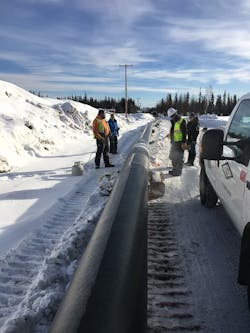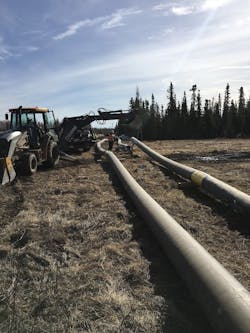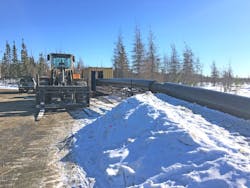About the author:
Steve Cooper is a writer for SCA Communications. Cooper can be reached at [email protected].
Alaska’s Department of Environmental Conservation discovery of sulfolane and per- and polyfluoroalkyls (PFAS) in the local drinking water wells of North Pole, Alaska, led to two new wells being dug outside of the 2-mile by 3-mile underground water plume.
To deliver the fresh water to the nearly 2,200 inhabitants of the city 14 miles southeast of Fairbanks, a high-density polyethylene (HDPE) potable water pipeline was installed. The 181,000 feet of PE 4710 IPS DR 11 HDPE pipe with a pressure rating of 200 psi in various diameters from Pipeline Plastics LLC provides a leak-free, seismic-resistant supply line. The project included both open cut as well as boring to install the 6-, 8-, 10-, 12- and 16-inch diameter pipe. To ensure uninterrupted water service even during Alaska’s harsh winters, the HDPE pipe was pre-insulated with polyurethane foam.
In all, the $52.1 million project will consist of 35 miles of pipe, expansion of the North Pole water treatment plant and a 750,000-gallon potable water reservoir. Service connections at nearly 700 homes and businesses will be added once the system becomes operational. Two of the four zones had been completed by June 2019 and all work is expected to be done during 2020.
The effort won the Project of the Year Award for the Plastics Pipe Institute Inc.’s (PPI) Municipal and Industrial Division. PPI is the major North American trade association representing all segments of the plastics pipe industry. The North Pole project team also included Wolseley Industrial Group/Ferguson (Distributor), Stantec (Design Engineer), Arctic Insulation (Fittings, Accessories) and Exclusive Paving of Fairbanks (Contractor).
“The North Pole water distribution project went through a few iterations prior to the formal tender,” said Matt Theilken, national sales manager of Thermacor Process, Inc., the pre-insulator of the HDPE pipe. “We looked at a range of carrier pipe materials, but in the end, HDPE made the most sense for the project. When looking at the life expectancy of a system, HDPE provides the best value and the longevity one would expect from such a large capital expenditure. The goal of the project was to build and install the pipeline from Fairbanks to North Pole and have 3 inches of insulation and jacketing around it. This would protect the pipe and keep the water from freezing as it’s transferred from Fairbanks.”
HDPE pipe is corrosion-resistant, which contributes to its long useful life. Theilken said he and the team added insulation and freeze protection for this application due to the conditions the pipe would endure. For this, the team used a high-density polyethylene jacket that had been manufactured from the same resin as the pressure pipe, PE 4710.
“The pipe is preheated prior to the spray application of the polyurethane foam,” he said. “It’s a reaction process, which makes the bonding of the foam to the pipe and jacket permanent. We use a side-head extruder to put the jacket directly on to the foam.”
A 10- to 12-inch cut back is left at the end of each stick of the pipe during manufacturing at the factory. Then at the site, crew members can clamp one end with the jacket, which has a compressive strength of 40 to 50 psi so as not to damage the insulation. The join closure kit then is used to seal the joint shut.
Despite being buried, the pipe could endure temperatures as low as -30ºF. Thermal expansion and contraction are concerns that are mitigated by the burial because of the bonding of the jacket to the foam insulation and that insulation bond to the pipe.
“The integrity of the fused joint is critical in a situation where groundwater contamination is present and has shaken the confidence of the city’s inhabitants,” explained Camille George Rubeiz, P.E., F. ASCE, senior director of engineering, Municipal and Industrial Division for PPI. “The harshness of the weather with temperatures way below zero required a material that could provide a long service life even in this rugged Alaskan environment. The pipe is PE 4710, which is the highest performance classification of HDPE piping material for water applications. It is tough, durable and flexible, plus it meets AWWA C906 and ASTM F714 standards. PE 4710 HDPE pipes provide zero-leakage, conserving water and preventing infiltration of contaminated water as was found at the North Pole.”
The strong heat-fused joint between the 50-foot lengths of pipe plus the flexibility of the PE 4710 pipe protects the entire pipeline from natural disasters, seismic activity and even earthquakes with enough magnitude to register on the Richter scale.
On May 29, 2019, a 2.6 magnitude earthquake hit the area, some 60 miles from North Pole, Alaska. During the past 365 days, the area has had 232 earthquakes registering 1.5 magnitude or greater.
“With nearly 34 miles of pipe being installed, it was imperative that each and every foot be able to withstand any seismic shift here at the North Pole,” Rubeiz stated.
Tony Radoszewski reiterated the extreme conditions in which this pipe was installed and the importance of this project for delivering potable water to the community.
“The City of North Pole, Alaska is in a sparsely populated, rugged environment with severe temperature swings, and unfortunately, contaminated water,” offered Tony Radoszewski, CAE, president of PPI. “When both groundwater and the local lake test positive for action level contaminats, the community is in trouble. But the new HDPE pipeline system will provide complete isolation from the contaminates at the North Pole, insulate the water from the temperature and environment, be able to survive the annual freeze and thaw cycle of the ground, and even provide uninterrupted service after occasional seismic activity that is frequent in the area.”
About the Author
Steve Cooper
Steve Cooper is a writer for SCA Communications. Cooper can be reached at [email protected].


